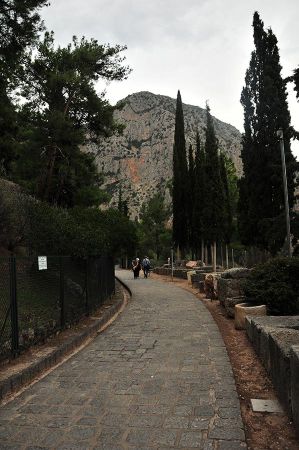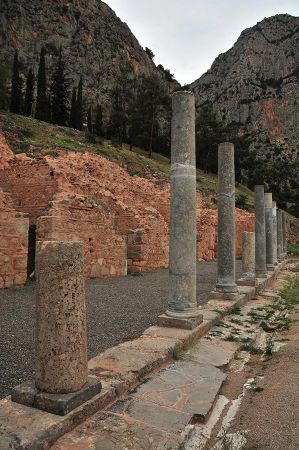Delphi - From the theatre up to the stadium
- Written by Portal Editor
Our way through the ancient ruins of Delphi leads us higher up the settlement hill, despite the already lower sun and partial cloudy sky, the rise was partly quite exhausting.
What kind of work the people of the ancient world were able to full fill to transport the heavy stone material up here, it is almost unbelievable. Directly after the sanctuary of the Apollo, the theater construction followed, a splendid but typical construction of the time, which gave place to around 5000 spectators.
Second Most Important Panhellenic Games of Antiquity
 After the completion of the theater building from the 4th century BC, the theater was the only place where musical parts of the Pythian games took place. The Pythian Games (also called Delphic Games) were the second most important Panhellenic games of antiquity after the Olympics. The historical epoch of the Pythian Games began as early as 586 BC, when the leadership of the Games after the end of the First Holy War passed to the Delphic Amphictyony, a council of the twelve Greek tribal groups.
After the completion of the theater building from the 4th century BC, the theater was the only place where musical parts of the Pythian games took place. The Pythian Games (also called Delphic Games) were the second most important Panhellenic games of antiquity after the Olympics. The historical epoch of the Pythian Games began as early as 586 BC, when the leadership of the Games after the end of the First Holy War passed to the Delphic Amphictyony, a council of the twelve Greek tribal groups.
Since then, they had not been held as before all eight years, but every four years, two years before the Olympic Games, and the probable date was the end of August. At the beginning, there were only musical competitions at the Pythian Games, initially the singing to the Kithara, later extended by singing to the flute and to solo flute play.
 These were also of greater importance in the case of the other great festivals, although the new design of the Pythia had also brought in the gymnastic competitions and the carriage and cavalry races.
These were also of greater importance in the case of the other great festivals, although the new design of the Pythia had also brought in the gymnastic competitions and the carriage and cavalry races.
For the time of the Delphic Games they created the Holy Delphic Peace, which lasted for three months. The arms rest assured the people - participants and spectators - a safe journey to the games and back to their homeland. It is also the enthusiasm of the audience. Many people came from all over Greece and brought the city considerable revenues.
The Agora, which was more an art market in the time of the Games, was considered an important trading place for art goods.
The "Notebooks" of Aristotle
 However, all the sources received emphasize the splendor of the games.
However, all the sources received emphasize the splendor of the games.
The records of Aristotle give an overview of the festivities: the games lasted six to eight days and began with a sacred game that represented Apollo's victory over Python.
In a solemn and glorious procession a great sacrifice was offered in the Temple of Apollo.
After a break, the games began on the fourth day. The musical disciplines included:
• A hymn to the god Apollo
• Flute and kitharas (old Greek string instrument) with and without vocals
• Drama and dance contests
• Painting competitions
 The Delphic Games were honorable games. The winners received no prize money, but a laurel wreath as an award, just as the olive branch was the award of Olympics.
The Delphic Games were honorable games. The winners received no prize money, but a laurel wreath as an award, just as the olive branch was the award of Olympics.
Apples also seem to have been presented sometimes as a fight prize, and the symbolic palm branch was given to the winner of the Pythnic Games as well as at the Olympic Games.
In the case of special honors, the competitor was also given a monument in the form of a statue. However, the prestige gained by the victor and his hometown was invaluable. The cities therefore supported their representatives with every possible means of cutting off as much as possible during the games.
Sporting competitions within the framework of Pythian Games
 Originally the games consisted only of a musical competition, later further artistic and gymnastics competitions as well as carriage and rider races were added.
Originally the games consisted only of a musical competition, later further artistic and gymnastics competitions as well as carriage and rider races were added.
The sports competitions within the framework of the Pythian Games were carried out in the still further uphill stadium. The horse contests took place in the neighboring plain of Krissa.
Further up the mountain, still far above the sacred grounds and the theater, the old stadium is integrated into the mountain world. It was built in the 5th century BC and has been rebuilt several times over the centuries.
Its still existing form was completed in the 2nd century when Emperor Herodus Atticus financed the stone seats and the arched entrance. There were about 6500 spectators sitting on the stone seats.
 The stadium, as already mentioned, was used extensively during the Pythian and Panhellenic games for sporting events and for music festivals. Its length is 177.55 m (about 550 feet) and the width is 25.50 m. A similarly well maintained stadium as in Delphi is also located in Afrodisias in today's Turkey.
The stadium, as already mentioned, was used extensively during the Pythian and Panhellenic games for sporting events and for music festivals. Its length is 177.55 m (about 550 feet) and the width is 25.50 m. A similarly well maintained stadium as in Delphi is also located in Afrodisias in today's Turkey.
The Pythian games were still celebrated in the time of the emperor Julian, and probably diminished at about the same time as the Olympic Games came to an end. In 394 AD, Theodosius I, Emperor of Rome and Byzantium, banned the Delphic Games as a pagan event.
Please read as well:
Delphi - the Theatre and the Sanctuary of Apollo
Delphi - the Treasure Houses along the Sacred road
-
 Delphi - Stadium and Theatre
Delphi - Stadium and Theatre
Delphi - Stadium and Theatre
Delphi - Stadium and Theatre
-
 Delphi - Stadium and Theatre
Delphi - Stadium and Theatre
Delphi - Stadium and Theatre
Delphi - Stadium and Theatre
-
 Delphi - Stadium and Theatre
Delphi - Stadium and Theatre
Delphi - Stadium and Theatre
Delphi - Stadium and Theatre
-
 Delphi - Stadium and Theatre
Delphi - Stadium and Theatre
Delphi - Stadium and Theatre
Delphi - Stadium and Theatre
-
 Delphi - Stadium and Theatre
Delphi - Stadium and Theatre
Delphi - Stadium and Theatre
Delphi - Stadium and Theatre
-
 Delphi - Stadium and Theatre
Delphi - Stadium and Theatre
Delphi - Stadium and Theatre
Delphi - Stadium and Theatre
-
 Delphi - Stadium and Theatre
Delphi - Stadium and Theatre
Delphi - Stadium and Theatre
Delphi - Stadium and Theatre
-
 Delphi - Stadium and Theatre
Delphi - Stadium and Theatre
Delphi - Stadium and Theatre
Delphi - Stadium and Theatre
-
 Delphi - Stadium and Theatre
Delphi - Stadium and Theatre
Delphi - Stadium and Theatre
Delphi - Stadium and Theatre
-
 Delphi - Stadium and Theatre
Delphi - Stadium and Theatre
Delphi - Stadium and Theatre
Delphi - Stadium and Theatre
-
 Delphi - Stadium and Theatre
Delphi - Stadium and Theatre
Delphi - Stadium and Theatre
Delphi - Stadium and Theatre
-
 Delphi - Stadium and Theatre
Delphi - Stadium and Theatre
Delphi - Stadium and Theatre
Delphi - Stadium and Theatre
https://www.alaturka.info/en/greece/delphi/3671-delphi-from-the-theatre-up-to-the-stadium#sigProId4c429ebed8
